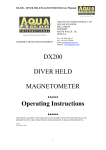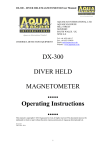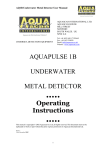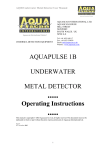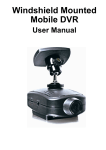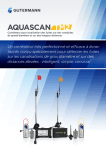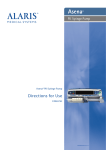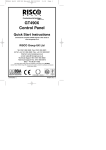Download dx-200 - Aquascan International Ltd
Transcript
DX-200 – DIVER HELD MAGNETOMETER User Manual AQUASCAN INTERNATIONAL LTD. AQUASCAN HOUSE HILL STREET NEWPORT. SOUTH WALES. UK NP20 1LZ UNDERSEA DETECTION EQUIPMENT Tel: +44 1633 841117 Fax: +44 1633 254829 Email: [email protected] Website : www.aquascan.co.uk DX-200 DIVER HELD MAGNETOMETER ..... Operating Instructions ..... This manual is copyright © 2009 Aquascan Int. Ltd, all rights reserved. This document must not be replicated in whole or part without the prior express permission of Aquascan International Ltd. Rev 5 18th Jan 2012 1 DX-200 – DIVER HELD MAGNETOMETER User Manual Page/Contents 1. Front 2. Page of Contents 3. Introduction Applications Example of appropriate use of the DX-200 4. General comments The DX-200 Equipment 6. Initial Testing of your DX-200 Charging the batteries 8. Underwater Operation 9. Care and Maintenance 10. Battery Care & Checking Battery Performance/Status 12. Troubleshooting Guide No Response from the DX-200 Module Erratic Performance from the DX-200 Module 14. DX-200 Specifications 15. DX200 Accessories 17. DX-200 Optional Accessories 18. DX-200 Professional Kit 19. Manufacturer Contact Information 20. EC Declaration of Conformity Product Guarantee – loose insert 2 DX-200 – DIVER HELD MAGNETOMETER User Manual Introduction The AQUASCAN name has been established for more than two decades and conveys the message of underwater detection excellence using Proton Magnetometers and Pulse Induction Metal Detectors (Aquapulse). The newest addition to the AQUASCAN line of underwater detection equipment is the AQUASCAN DX-200 DIVER HELD MAGNETOMETER. The DX-200 is a hand-held gradient magnetometer, utilizing fluxgate technology. It is ideally suited for an array of search applications, both on land or underwater. Applications Wreckage – The DX-200 is the ideal tool for the location of buried ferrous wreck material. There are unlimited applications in all types of archaeological wreck investigation. It is the ideal diver-operated tool to locate items buried deep in sediment. It allows accurate mapping of all buried ferrous material prior to seabed disturbance. It can also detect the presence of some forms of ballast material, which in many cases gives a magnetic response. Pipes and Cables – The DX-200 is also ideal for locating and mapping pipes and armoured cables buried in sediment. It can detect at burial depths of between 1 metre and 7 metres, dependent on the diameter of the pipe or cable. E.O.D & Security – There are unlimited applications in all types of underwater investigation for the presence of ordinance, weapons etc. Salvage – The DX-200 is a useful tool for the successful recovery of lost items either in low visibility or where lost in soft sediment. It is the ideal tool to complement surface operated searching. The tool most requested by users of boat-towed magnetometers is a diver-held device to help pinpoint magnetometer targets located with a conventional towed-magnetometer. The DX-200 fills this need extremely well. Example of appropriate use of the DX-200 The following is an example of an application where the DX-200 might be utilised with great success and great savings in time and effort. A magnetometer target is found with a boat-towed system in 35 feet of water. The visibility is minimal and, upon examination by a diver, the bottom is found to be flat sand and no target could be detected within the range of a metal detector. The DX-200 is taken to the bottom by the diver, after the unit is switched on and set to Hi sensitivity, the diver scans the identified area in a series of straight lines radiating out from the initial seabed marker and notices an increase in the audio frequency in one direction. Moving slowly in the direction where the audio output of the DX-200 increased, the diver notes where the peak response occurs; using the range switches to 3 DX-200 – DIVER HELD MAGNETOMETER User Manual desensitise as necessary to note the point where the peak response occurs. The diver next determines if a larger peak response can be on a line that intersects at 90 degrees to the original search direction, this will assist in determine the exact centre of the target and to an extent the size and shape of the target. The above described technique using steady straight line searching and use of the range switches to reduce the sensitivity where necessary to determine the true centre of the response will pay dividends in terms of diver bottom time and in focussing any following excavation in the most likely productive area. General comments The DX-200 is NOT a metal detector. It detects localised disturbances in the earth’s magnetic field that are caused by the presence of ferrous material. The user should note that other things can cause magnetic disturbances that will affect the DX-200 operation. These include electromagnetic fields produced by electrical and electronic devices. Working around large industrial areas or under transformers and high tension power lines will generally give the user problems with false readings. In the water it is just important to be clear of any influence that may be generated by a large steel vessel; and of course equipment on the diver such as a steel dive cylinder. If you are searching for small items of debris, such as a cannonball, a pistol, a hand tool; you will probably be more successful utilising a metal detector such as the Aquascan AQ1B. The DX-200 is more suited towards larger items, which will cause a larger magnetic deviation. The DX-200 is ideal for commercially searching for buried UXO, pipes, cable and large ferrous debris. For archaeologists and wreck hunters it is ideal for locating cannons, anchors, chains and other large ferrous items that can confirm the presence of a buried wreck site. Large ferrous masses will be detected at greater distances than smaller masses and will be noted to have a much slower build up to the peak audible response. The DX-200 Equipment A standard AQUASCAN DX- 200 kit consists of the following items: 1. 2. 3. 4. 5. 6. Sealed electronic unit Bone conductor earphone (Bonephone) . Sensor Probe with cable and plug. Mains Battery charger (100-250v) with AC charging lead. D-Ring mounting system. Operating instructions. 4 DX-200 – DIVER HELD MAGNETOMETER User Manual The Aquascan DX-200 Diver Held Magnetometer is a precision built instrument using the latest Fluxgate magnetic sensors, and has been designed for both ease and simplicity of use in the underwater environment, featuring three sensitivity settings for use in pinpointing targets.. The unit is ruggedly built to withstand normal diving usage, but to get the best trouble-free operation and long life, certain simple operation and maintenance procedures must be followed. Read the instructions carefully before diving with your DX-200. 5 DX-200 – DIVER HELD MAGNETOMETER User Manual Initial Testing of your DX-200 Note: It is highly recommended that you familiarize yourself with the DX-200 on land before taking it into the water. This section explains the basic functionality of the DX-200 and how to use the controls. It is much easier to learn to operate the unit without the challenges of limited visibility, restrictive dive equipment, currents, etc. So, please take the time to perform this Initial Testing of your unit before venturing into the water with it. 1. Charging the batteries The DX-200 is supplied only partially charged and will require a full 14 hours charging duration to bring the unit to a fully charged status. Make sure the DX-200 is in the OFF position. Plug the output lead from the charger into the AUDIO & CHARGE socket on the control bulkhead. Please note that this can only be inserted one way round due to the locating (polarising) pin. Screw down the retaining collar. This should be good finger tightness only. N.B. DO NOT ON ANY ACCOUNT PLUG THE CHARGER INTO THE PROBE SOCKET AS DAMAGE MAY BE DONE TO THE ELECTRONICS Ensure the charger is correctly connected to the Charge/Audio socket before plugging the charger into the mains supply (100 – 250vAC). After running for an hour or so the charger may get slightly warm to the touch. This is quite normal. N.B. THE TYPE OF CHARGERS SUPPLIED WITH THE DX-200 CHARGE AT A REGULAR RATE FOR APPROXIMATELY 14 HOU HOURS AND THEN GO INTO A TRICKLE CHARGE (MAINTENANCE) MODE. WHILE CHARGING AT THE REGULAR RATE, THE GREEN LIGHT WILL BE ON. ONCE THE CHARGER DROPS INTO TRICKLE CHARGE MODE, THE LIGHT WILL GO OUT. THIS SHOULD NORMALLY TOP OFF THE CHARGE IN THE BATTERY PACK AFTER A DAY OF WORK. BUT, IF YOUR DX-200 IS FULLY DISCHARGED, YOU SHOULD WAIT UNTIL THE LIGHT GOES OUT, THEN UNPLUG THE CHARGER FROM THE MAINS AND PLUG IT BACK IN TO INITIATE ANOTHER REGULAR 6 HOUR CHARGE CYCLE. The batteries will not be damaged by being left on charge for a longer period than necessary due to the controlled charge current (14hr rate). If the batteries become fully discharged - due to natural usage for the maximum operating period or through the unit accidentally being left in the on state – the unit should be fully recharged as soon as possible to avoid irreparable damage to the battery cells (see above for charging from a discharged state). N.B. DO NOT USE ANY OTHER BATTERY CHARGER THAN THE ONE SUPPLIED AS DAMAGE TO THE BATTERY PACK MAY RESULT. 6 DX-200 – DIVER HELD MAGNETOMETER User Manual When the charge period has elapsed, disconnect the AC supply to the charger first, and then unplug the connector from the socket on the detector. 2. For initial testing on land, you will have to find a location where you can position yourself at least 30 metres from any large ferrous objects in all directions. Get rid of anything containing iron on your body or in your clothing – and leave your cell phone at home. An empty farm field or park, or sports field is ideal for testing. Park your car at the edge of the field (at least 20 metres from where you will be testing), or find a location where there is some large ferrous target in one direction only. 3. To prepare the DX-200 for use, plug the connector on the Sensor Probe into the SENSOR socket and screw down the retaining collar. This should be good finger tightness only. N.B. DO NOT EVER USE PLIERS OR OTHER TOOLS TO TIGHTEN THE PLUG COLLARS. THESE ARE DESIGNED TO BE USED FINGER TIGHT WITH THE BLACK RUBBER BULKHEAD SEAL IN PLACE ON THE PLUG PINS. OVER-TIGHTENING, OR INSTALLING THE PLUG WITHOUT THE RUBBER SEAL CAN PERMANENTLY DAMAGE THE SOCKET, WHICH MAY CAUSE THE CONTROL UNIT TO FLOOD. Note: This plug can only be inserted one way round due to the polarising pin. 4. Plug the connector on the Bonephone (or headphone) lead into the PHONE & CHARGE socket and screw down the collar as above. NB. For testing on land the headphones – if available - are much easier to work with. 5. Locate yourself to the centre of the testing area, hold the Sensor Probe at full arm’s length from your body, pointing down at about 45 degrees, and switch the unit on by rotating the POWER – SENSITIVITY control to the LO position. If a continuous sound is heard immediately, the SET AUDIO control should be rotated one way or the other until the audio threshold is reached; this is indicated by a low frequency ticking sound in the Bonephone/Headphones. There is a “centre point” where you will achieve the low frequency ticking sound, and turning the SET AUDIO control either way from this point will result in an increase in the audio output. Note: The SET AUDIO control is a 10-turn potentiometer. Do not turn it past its stop point in either direction or permanent damage will result. The audio threshold should be somewhere in the middle of the 10 turns, so just start turning one way until you either reach the audio threshold or the stop point of the control. If you reach the stop point without finding the audio threshold, start turning the other way until you do. Once you have found the audio threshold the first time you test the unit, the SET AUDIO control should be in the near vicinity of the correct location for future uses, so you will normally just need to tune it back and forth a few turns unless someone has turned it away from this setting. 7 DX-200 – DIVER HELD MAGNETOMETER User Manual 6. Once you achieve the audio threshold adjustment, turn the POWER SENSITIVITY control to HI. You will probably have to make minor adjustments to the threshold setting when you switch to HI. Once you have the threshold set to the low frequency ticking, you are ready to begin testing. Test the operation of the DX-200 by turning slowly in a circle with the Sensor Probe pointed down at about 45 degrees. As the Sensor Probe is pointing in the direction of a target, you should hear an increase in the audio output. If you make a full circle without noticing any change in the audio output, move 5 metres closer to your target and complete the circle test again. 7. Once you are able to detect an increase in the audio signal frequency or pitch, you should be able to move the Sensor Probe back and forth in an arc and notice where the highest audio output occurs, which should be as the probe is pointed directly at the target. Using this technique, you can use a sweeping motion of the probe to actually walk yourself to the target. 8. As you get closer and closer to the target, the DX-200 will begin to have constant audio output, so you will need to lower the sensitivity to be able to actually pinpoint the target. Do this by changing the SENSITIVITY setting to MED. And, then as you get even closer, change the setting to LO. 9. If possible, experiment with several different targets of different sizes to get an idea of how the unit behaves under different circumstances. Having performed the above checks on land, you are now ready to use the Aquascan DX-200 in the water. Underwater Operation NOTE: As explained above in the Land Test, you must be free of objects containing ferrous materials. Steel dive tanks are probably out of the question. Most Stainless Steel does not actually contain any iron, so it usually won’t interfere with the operation of the DX-200. But check yourself carefully; something as small as a set of keys can affect the operation of the unit and give you false readings. Also, don’t try to operate the unit in the vicinity of a large steel vessel. 1. The control unit of the DX-200 can be worn or carried in a number of ways; the choice will be influenced by the conditions and diver preference. The most obvious choice is worn clipped to any suitable location on the diver with the DRing mounting system provided with the unit. Other options include the quick release belt harness; strapping it to the upper arm, or mounting it to the DX-200 Armsaver optional accessory (see section DX-200 Optional Accessories). 2. The Bonephone should be placed under the hood. If no hood is worn, it can be placed under the strap of the facemask or under a suitable neoprene headband. Position the Bonephone so that it is on a bony part of the head close to the ear. N.B. NEVER PLACE THE PHONE DIRECTLY OVER THE EAR AS THIS COULD INTERFERE WITH PRESSURE EQUALISATION ON THE EARDRUM. 8 DX-200 – DIVER HELD MAGNETOMETER User Manual 3. Dive to the search area to be searched. 4. Switch the unit on and rotate the SENSITIVITY control to HI. Hold the Sensor Probe at full arm’s length in front of you and pointing down at about 45 degrees. Rotate the SET AUDIO control to achieve the audio threshold point, keeping the Sensor Probe at arms length and angled down at about 45 degrees. 5. If you are trying to pinpoint a “hit” from a towed magnetometer, the standard procedure is to start scanning around in a complete circle. If you detect even the smallest change in audio in any given direction, move in that direction and repeat the scan. Just as in the Land Test above, you should be able to guide yourself right to the target by following the Sensor Probe and adjusting the SENSITIVITY control down to MED and the LO as you get closer. 6. If you are just doing a general search of an area, you will probably want to establish some sort of grid and move in straight lines, scanning back and forth in an arc to insure you cover the entire area to be searched. Note: Different environmental conditions may make a small difference to the threshold setting as you perform your search, which can be readjusted by the SET AUDIO control knob. Care and Maintenance Proper care of your Aquascan DX-200 will be repaid by a long and trouble free life and attention should be given to the following points: 1. After use, and before removing plugs, make sure that the unit is switched off, and wash down with clean fresh water. NEVER use chemicals to clean your DX200 as these will damage o-rings and seals, which can cause them to fail and allow the incursion of water into the control unit. 2. Remove the Sensor Probe and Bonephone/Headphones plugs from the bulkhead sockets, and make sure the Rubber Seal is free from sand or other debris (remove and clean if necessary). Dry off the plug pins and blow any moisture out of the sockets. You can use a Q-Tip to clean and dry the sockets. Ikelite does not recommend using silicone grease or any other material on the connectors. The rubber seal provides adequate isolation of the connectors from the water. Use of these type products tends to accumulate sand and other debris which can actually interfere with the seal. Never utilize petroleum products such as Vaseline, since these will harden the rubber seal making it non-functional. The rubber seal should be replaced any time it becomes stiff, as this will interfere with its function. Note: A dirty or corroded connection is the most common cause of poor performance of underwater detection equipment. Keep your connectors clean and dry between uses. 9 DX-200 – DIVER HELD MAGNETOMETER User Manual 1. Dry the DX-200, paying particular attention to the area around the plugs. 2. Clear any excess water present on the bulkhead by blowing or wiping with a soft cloth. 3. Recharge the batteries if the total hours used is approaching 10. 4. Never leave your DX-200 lying in the hot sun, as this could raise the internal temperature to the point where it may distort the case and harm the electronics. This warning also applies to the Sensor Probe and headphones/Bonephone. 5. The electronic unit is sealed and pressure tested in the factory, no attempt should be made to access the electronics. If any servicing is required, contact your supplier who will advise you where to send the unit. Battery Care & Checking Battery Performance/Status The DX-200 internal battery pack is an 8-cell series NiMH AA size pack giving a capacity of approximately 2800mA/Hrs. This capacity relates to an operational period of between 10 and 12 hours from full charge. Note: self-discharge occurs naturally in a rechargeable battery. During inactivity this self-discharge causes the battery to slowly discharge itself over a period of months. To maintain maximum performance it is important to charge your DX-200 before use. Checking Battery Pack Performance Note: For routine maintenance this should be carried out every three months. The recommended procedure is as follows: 1.0 Connect the Sensor Probe to your DX-200 module. 1.1 Power on your DX-200 and leave it on overnight to fully discharge the battery. 1.2 Power off the DX-200 and disconnect the Sensor Probe. 1.3 Charge the DX-200 for at least 14 hours using the provided charger. 1.4 Once the DX-200 is fully charged, disconnect the charger. 1.5 Connect the Sensor Probe and Bonephone/Headphone to the DX-200 unit and switch it on. Place the Sensor Probe away from any ferrous target and adjust the SET AUDIO control to get a steady slow ticking sound if possible. This may be difficult if you are inside a building due to the electronic noise and many metal objects. 1.6 Make a note of the time. 10 DX-200 – DIVER HELD MAGNETOMETER User Manual 1.7 Confirm the functionality of the unit every 30 minutes - re-adjusting the tickover as necessary. 1.8 When it becomes impossible to set the threshold, or the audio ceases altogether, this can be considered to be the end of charge status for the battery. This should be in the range of 10 to 12 hours for a healthy battery pack. 1.9 If the performance becomes unacceptable after less than what you (the operator) determine to be an acceptable minimal operational period, then the DX-200 Battery Pack needs to be replaced. Note: If your battery needs to be replaced please contact our technical support dept to arrange for an installation of a replacement battery, or in the case of an approved service agent please refer to the servicing data provided. Please consider NiMH batteries as hazardous material and dispose of your old battery pack in line with local guidelines. 11 DX-200 – DIVER HELD MAGNETOMETER User Manual Troubleshooting Guide Symptom: No Response from DX-200 Module Check the following:1. Check that the battery has been charged – as the voltage drops below a certain point, erratic behaviour will result. Further decrease in voltage will result in total lack of functionality. >If not, place DX-200 on charge and then re-test. 2. Check that both Sensor Probe and Bonephone are correctly connected 3. Try using an alternative Bonephone/AQ1B Headphones. 4. Try using an alternative Sensor Probe if available. 5. Check that both the Sensor Probe and Bonephone are in good condition. Check by substitution if possible or by monitoring the nominal resistance of Bonephone/Headphones. Connecting a good quality multi-meter across the pins of the plug can check the resistance. NB. It is good policy to firstly check the multi-meter’s reading with the leads shorted together - this provides a measure of what residual reading to take into account. >See DX-200 Resistance Chart below: Item Bonephone Land Headphones U/W Headphones 6. Symptom: Resistance (ohms) 5.4 15.0 (Minimum Volume) 10.5 There is no user test for the Sensor Probe other than visual mechanical inspection. Inspect the connector and cable, looking for any signs of damage that could allow ingress of water into the cable or connector. If damage is found, contact your Aquascan agent for servicing/replacement. Erratic Performance from DX-200 Module 1. First check as above. 2. Check that the contacts of the bulkhead connectors are clean. 3. Check that the connectors of the Sensor Probe and Bonephone are clean. If necessary reduce the contact resistance by slightly prising the gap in the male contacts, this will increase the firmness of the connector on insertion. 12 DX-200 – DIVER HELD MAGNETOMETER User Manual 4. Check for visible damage to Sensor Probe cable and connector, which could have caused water ingress. 5. Check that the male connector seals are in place and clean. 6. If you are unable to determine the cause of the erratic behaviour, contact your Aquascan agent for assistance. 13 DX-200 – DIVER HELD MAGNETOMETER User Manual DX-200 – SPECIFICATIONS MATERIALS & DIMENSIONS: INSTRUMENT CASE Housing material .......................... Machined uPVC Housing Dia ................................................ 100mm Overall length ............................................. 187mm MAGNETOMETER PROBE Probe housing.................................................. GRP Probe Dia ..................................................... 25mm Probe Length ............................................... 750mm CABLE Construction .............................. Twin core + shield Diameter - .................................................... 4.5mm Sheath................................................. Polyurethane Length ............................................ 2m (approx 6ft) POWER Power .......... Internal Rechargeable NiMH battery Charger .............................. Universal 100-250v AC Charge time (from empty) ............................ 14Hrs CONTROLS Power ........ On/Off – Incorporated with Sensitivity Sensitivity Switch .................Off/ Low/Med/High Set Audio ......................................... Multi-turn Pot WEIGHTS Control Unit ..................................................... 1Kg Probe & Cable ............................................... 0.7Kg Basic outline of Case & Sensor Stem 14 DX-200 – DIVER HELD MAGNETOMETER User Manual DX-200 - ACCESSORIES AQ.4.061 DX-200 Bonephone – Fully waterproof headphone that utilises an Ikelite underwater connector to connect to the DX-200 Control Module. The low profile module is normally placed against the skull; below or behind the ear whilst underwater, enabling the diver to clearly hear the change in the Detector tone when metal is sensed. AQ.4.062 DX-200 Bonephone – with extending flex cable. This version is in all other respects the same as the AQ.4.061. The option of a flexible cable that will extend and retract is preferred by some divers; particularly in low visibility conditions to minimise the risk of the cable fouling any obstructions. AQ.4.030 DX-200 Land Headphones – Rugged headphones optional accessory for use above water; enabling The DX-200 to be utilised as a powerful ferrous metal land detector. The Headphones feature an adjustable volume control and a comfortable fit for the user. AQ.4.031 DX-200 Underwater Headphones – Rugged headphones for use underwater giving an alternative to the Bonephone. These phones are particularly useful in warm waters where a diving hood is not normally worn, They also provide a more powerful sound level that can enhance the ability to sense even the most subtle changes in the audible output. 15 DX-200 – DIVER HELD MAGNETOMETER User Manual AQ.4.010 Battery Charger – Switched mode unit with 100v to 250v AC 50/60HZ input voltage range this unit is used to recharge the internal battery pack of the DX-200 Control Module. The charger can be supplied with option of US, UK or European type Power Connector in the form of a push-fit shoe or as a conventional power lead. DX-200 Control unit with standard D-Ring harness 16 DX-200 – DIVER HELD MAGNETOMETER User Manual DX-200 – OPTIONAL ACCESSORIES Optional DX-200 Armsaver – probe extended Optional DX-200 Armsaver – probe retracted DX-200 Control Unit mounted in optional Armsaver Close up of DX-200 Armsaver Probe connection 17 DX-200 – DIVER HELD MAGNETOMETER User Manual DX-200 – PROFESSIONAL KIT DX-200 Professional Kit - Case closed DX-200 Professional Kit Includes: Optional Shipping/Carrying/Storage case for DX-200. Control Unit, Sensor Probe, D Ring, Waist Belt, Charger, Bonephone, Underwater Headphones, and Armsaver. 18 DX-200 – DIVER HELD MAGNETOMETER User Manual Manufacturer Contact Information If you should need to contact Aquascan International Limited for advice on your purchase, to order further equipment or to arrange a repair, please use the following contact information: - Mailing Address: Aquascan International Limited Aquascan House Hill Street Newport South Wales NP20 1LZ United Kingdom Tel: Fax: +44 (0) 1633 841117 +44 (0) 1633 254829 E-mail: Sales Enquiries: [email protected] General Inquiries: [email protected] Technical Support: [email protected] Website: www.aquascan.co.uk Aquascan International Ltd. 19 DX-200 – DIVER HELD MAGNETOMETER User Manual EC Declaration of Conformity We hereby declare that the following equipment complies with the essential requirements at the Electronic Compatibility Directive (89/336, 91/26 3 and 92/31). This equipment should not be modified, without our approval, as this declaration will lose its authority. Equipment description: - Diver Held Magnetometer. Model: - DX-200. Manufacturer: - Aquascan International Ltd . Aquascan House Hill Street Newport, NP20 1LZ S. Wales. Tel: +44 (0) 1633 841117/255645 Fax: +44 (0) 1633 254829 Email: [email protected] Applicable directives : Group 1. EN 55011 General Emission Standard Class A, EN 50082 Generic Immunity Standard Part 2. A technical construction file for this equipment is retained at the manufacturing base. 1st January 1996 Signed :- ..............................................…… Date :- .......................................... J. R. WILLIAMS Managing Director Name :- .................................................. Position :- ..................................... 20




















